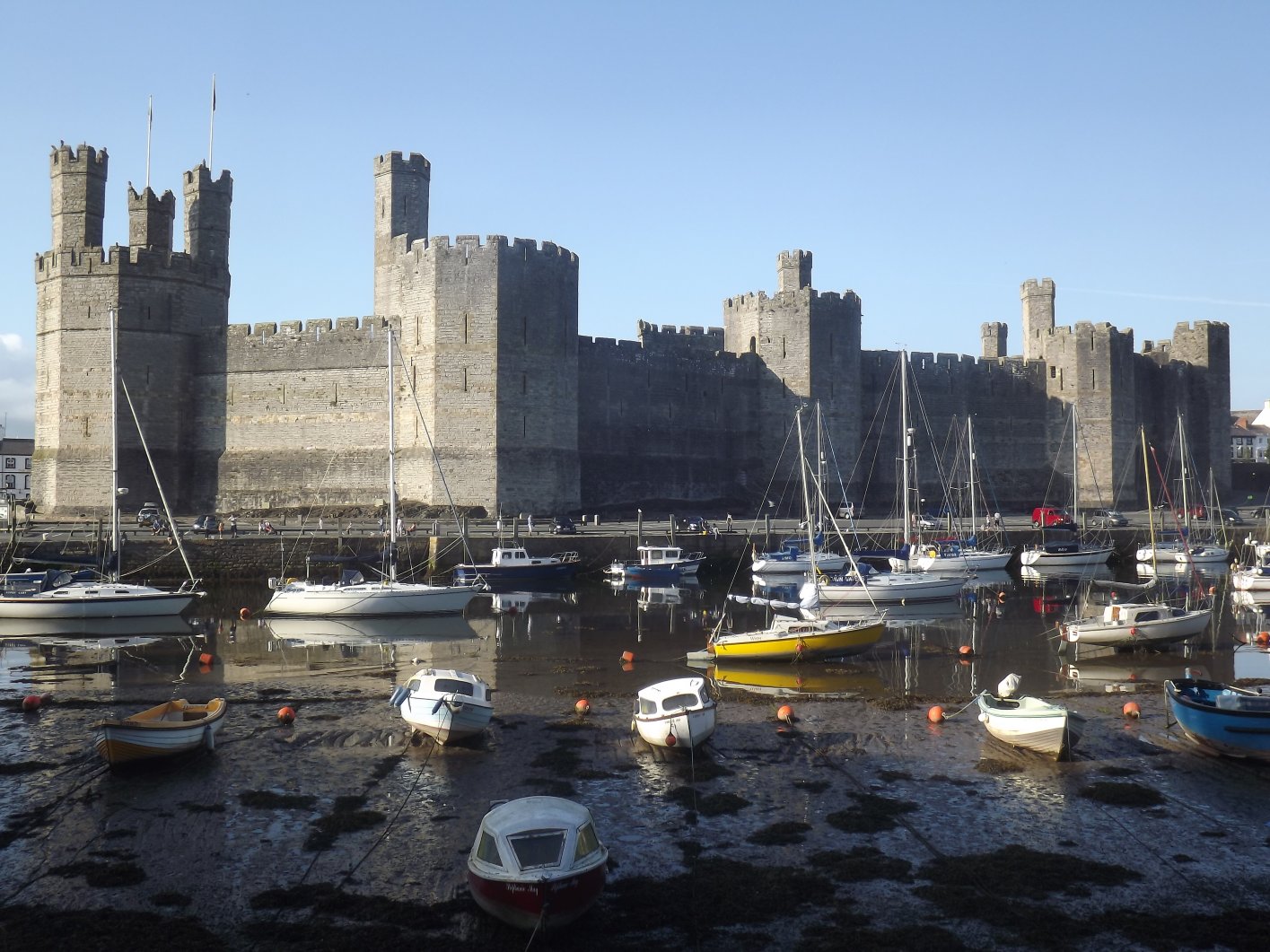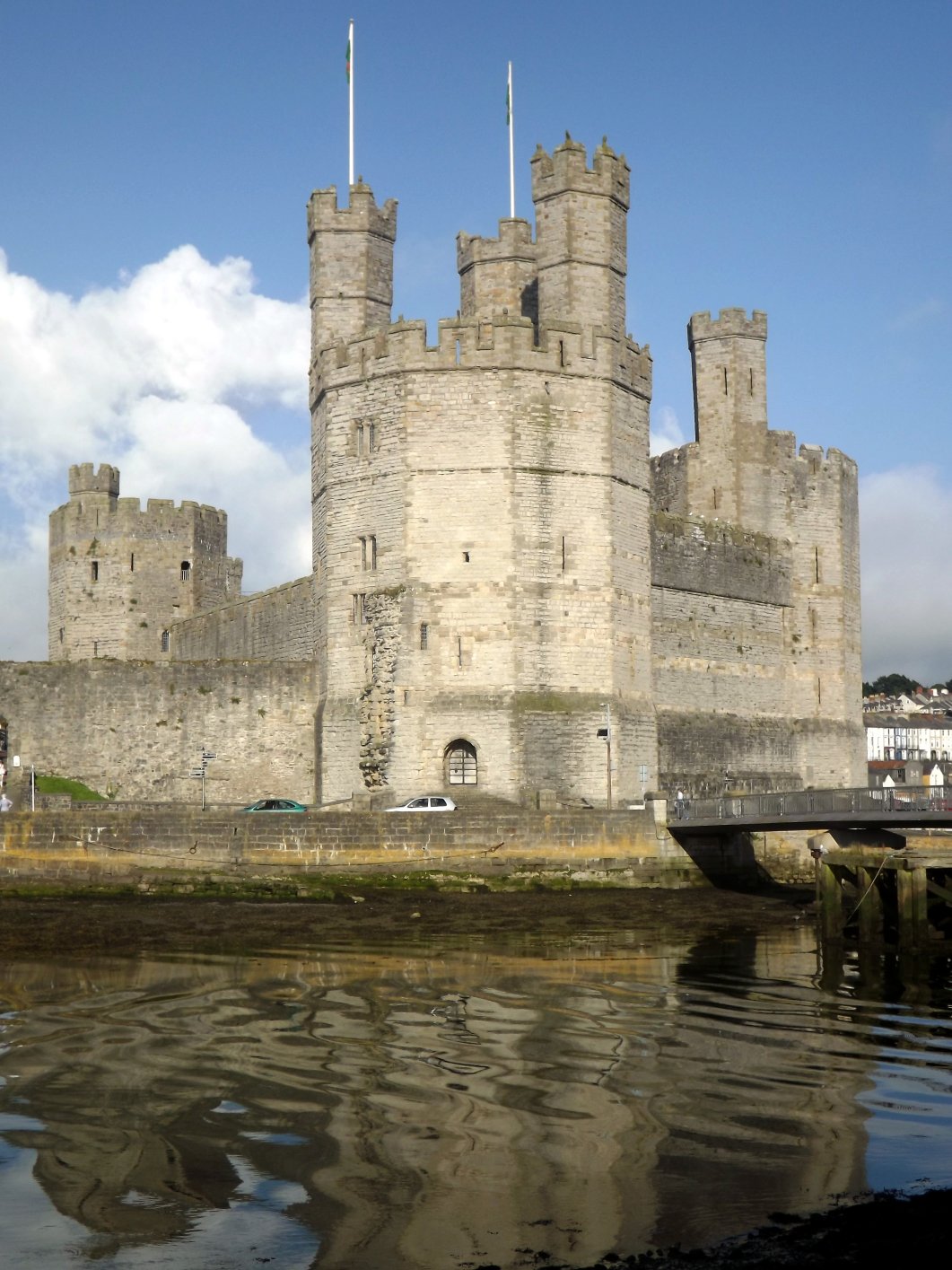 Caernarfon is a large castle with attached fortified town. A
Roman fort was built at Segontium on the hill above the present
fortress. The remains of this are still visible from the
castle. When the fort decayed a stone llys seems to have been
constructed nearer the river. In time this too was replaced
when the Normans came in the late 1070s or 1080s. The walls
of this castle are mentioned in a poem of 1157 describing the nearby battle of Tal Moelfre on Anglesey. A castle at Caernarfon
remained in use until the victorious Edward I arrived in 1283 and began
the construction of the castle we see today. The unfinished
castle was sacked in 1294 and then rebuilt again. On Edward's
death in 1307 the upper ward of the castle was standing as well as the
borough defences. Edward II completed the bulk of the
fortress and his statue from 1321 still dominates the remains of the
great gate to the east. During Glyndwr's war the castle was
attacked twice by Gallo-Welsh forces, but the emaciated garrison held
them off. During the civil war the castle proved its worth,
but eventually surrendered and was subsequently demilitarised and
abandoned. It was later refurbished as the tourist attraction
it is now. A recent tradition has grown up that the walls of
Caernarfon are based on those of Constantinople due to a medieval Welsh legend
that links the two together.
Caernarfon is a large castle with attached fortified town. A
Roman fort was built at Segontium on the hill above the present
fortress. The remains of this are still visible from the
castle. When the fort decayed a stone llys seems to have been
constructed nearer the river. In time this too was replaced
when the Normans came in the late 1070s or 1080s. The walls
of this castle are mentioned in a poem of 1157 describing the nearby battle of Tal Moelfre on Anglesey. A castle at Caernarfon
remained in use until the victorious Edward I arrived in 1283 and began
the construction of the castle we see today. The unfinished
castle was sacked in 1294 and then rebuilt again. On Edward's
death in 1307 the upper ward of the castle was standing as well as the
borough defences. Edward II completed the bulk of the
fortress and his statue from 1321 still dominates the remains of the
great gate to the east. During Glyndwr's war the castle was
attacked twice by Gallo-Welsh forces, but the emaciated garrison held
them off. During the civil war the castle proved its worth,
but eventually surrendered and was subsequently demilitarised and
abandoned. It was later refurbished as the tourist attraction
it is now. A recent tradition has grown up that the walls of
Caernarfon are based on those of Constantinople due to a medieval Welsh legend
that links the two together. The castle is entered via the main great
gate with its statue of Edward II. This powerful structure is
heavily defended and internally the gatepassageway turns 90 degrees to
the north into the outer, lower bailey. This is an unusual
design and the masonry decoration of this section strongly suggests
that two gatehouses of different ages have been combined. The
inner one quite possibly dates to the age of the Welsh
princes. Within the enceinte the upper ward has four great
polygonal towers, two turrets and two twin towered gatehouses with an
extra, apparently earlier gatehouse to the lower ward. The bulk of this
is the work of Edward I, though there are several large additions and
much of the work is unfinished or demolished internally. The
lower ward, with the impressive well tower and two more even larger
towers was largely constructed by Edward II. Both wards
combined are about 500' long by 150' wide.
The castle is entered via the main great
gate with its statue of Edward II. This powerful structure is
heavily defended and internally the gatepassageway turns 90 degrees to
the north into the outer, lower bailey. This is an unusual
design and the masonry decoration of this section strongly suggests
that two gatehouses of different ages have been combined. The
inner one quite possibly dates to the age of the Welsh
princes. Within the enceinte the upper ward has four great
polygonal towers, two turrets and two twin towered gatehouses with an
extra, apparently earlier gatehouse to the lower ward. The bulk of this
is the work of Edward I, though there are several large additions and
much of the work is unfinished or demolished internally. The
lower ward, with the impressive well tower and two more even larger
towers was largely constructed by Edward II. Both wards
combined are about 500' long by 150' wide.Copyright©2016
Paul Martin Remfry